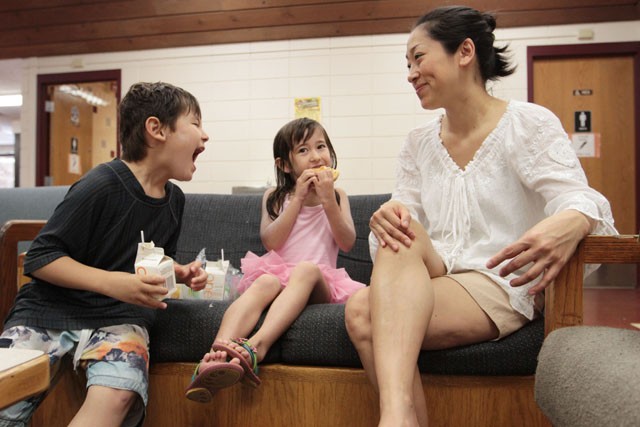Angelina Biggs doesnâÄôt usually eat much. But on Monday, the 5-year-old surprised her mother, Keiko Biggs, by eating every bit of her lunch âÄî even the fruit.
âÄúThis makes me happy,âÄù said Keiko Biggs, a Southeast Como resident and stay-at-home mom. âÄúWe are so grateful. IâÄôve been looking for something like this for a while.âÄù
Angelina Biggs and her 7-year-old brother, Elijah, eat for free at Van Cleve Park as part of the federally funded Summer Food Service Program. Van Cleve Park is one of 110 Minneapolis sites offering free meals to children under 18.
The program serves lunch and an afternoon snack five days a week to children from the neighborhood. Van Cleve Park Director Scott Krueger said 25 to 30 children eat there each day.
The meals, which have two servings of a fruit or vegetable, a sandwich and milk, are prepackaged at Minneapolis Public SchoolsâÄô Nutrition Center and shipped to each site.
âÄúThese types of programs are so beneficial to us because we are low income,âÄù Biggs said, after explaining that her husband is a full-time student. âÄúIf there is no food at home, having a place to go brings me peace.âÄù
When schools close their doors for the summer, many children on free or reduced meal plans are left without a steady place to find a nutritious meal, Nicole Barron of the Minneapolis Public Schools Food Service Department said.
The U.S. Department of Agriculture created the nationwide program more than 30 years ago to combat the âÄúnutrition gapâÄù and possibility of children going hungry without school meals during summer months, Barron said.
Minneapolis Public Schools coordinates the Summer Food Service Program for the sites in the city. The USDA reimburses each site for the meals they provide after the program ends Aug. 18.
The 110 sites across the city served more than 317,000 meals through the program last summer, Barron said.
The Minneapolis program operated last summer with $800,000 in reimbursements from the USDA and a little help from Minnesota Department of Education, she said.
More than 50 percent of children in the neighborhood have to qualify for free or reduced lunch in order for a site to qualify.
âÄúIn this area, there are probably people that depend on getting free lunch at school,âÄù Joan Johnson said, as her two grandchildren opened their free meals after a morning in the park.
Her grandchildren live a few blocks from Van Cleve with their parents âÄî both University of Minnesota medical students. She said the program is a great community resource for student parents.
âÄúItâÄôs no secret that students are traditionally poor,âÄù she said. âÄúI wish my daughter would have known about this sooner.âÄù
Krueger said the program has become a valuable community resource for an area that hosts people of all backgrounds, races and economic situations.
Krueger, who lived in Southeast Como as a University undergraduate about five years ago, said summer youth programming at the park disproves misconceptions that the neighborhood is dominated by âÄúcollege life,âÄù and shows that âÄúfamily lifeâÄù exists there.
Preschool enrollment has been steadily increasing at the park, he said, which means âÄúmore families are coming in.âÄù
Alisha One Feather agrees. The young, single mother said programs like the Summer Food Service Program make families feel welcome and help them feel more confident as parents.
Removing the cost, time and pressure it takes to provide meals for their children allows her to just enjoy spending time with her daughter, she said.
Minneapolis Public SchoolsâÄô Food Service Department staff monitors each site on a weekly basis to ensure guidelines have been followed and that no food is going to waste. Sites vary from churches to community centers to Minneapolis Parks and Recreation centers.
School districts throughout the state, including St. Paul Public Schools and Duluth Public Schools, also host the program.
One Feather said she brings her 1-year-old daughter and four nieces and nephews to the park for a snack and playtime at least twice per week.
âÄúThey love it,âÄù she said. âÄúItâÄôs healthy and it gives this community a hand in feeding our children.
âÄúTheir only problem,âÄù she added, âÄúis sometimes they wish there were seconds.âÄù








